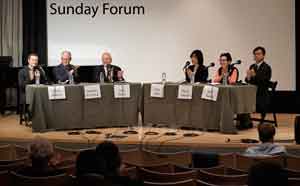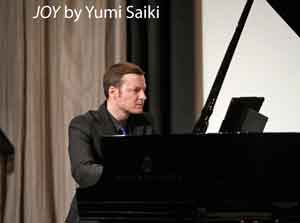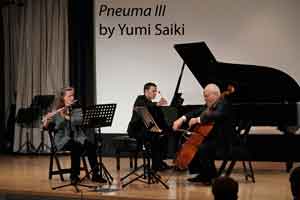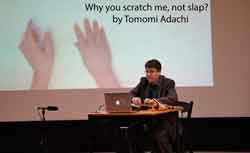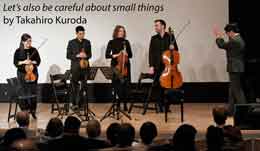
All photos to the right by Ken Howard
Festival 2019
44th Season
Fourth Artist Residency
March 2nd, 7:30pm: Japanese Composers Influenced by John Cage
March 3rd, 5:30pm: The Works of Yumi Saiki
Victor Borge Hall/Scandinavia House
58 Park Avenue at 38th Street
New York, NY 10016
March 2nd
For its Festival 2019, the Fourth Artist Residency, Music From Japan invited composer Yumi Saiki and musicologist Miyuki Shiraishi for a series of concerts and other educational events in New York City. To begin the festival, professor Shiraishi, who curated the March 2nd program, delivered a lecture titled John Cage in Japan: Shock and Afterwords. She traced the reception of Cage and of his music in Japan, from his first visit in 1952 until he won the Kyoto Prize in 1989, and beyond.
The Shirarishi-curated concert Japanese Composers Influenced by John Cage began with Jo Kondo’s piece Dithyramb, a duo for flute and guitar. Oren Fader (guitar) and Elizabeth Brown (flute) brought this playful and melodically refined piece to life. Yoichi Sugiyama’s Smoking Prohibited, a Bay Street Ballad II, New York Version is a piece for alto saxophone composed in honor of Eric Garner. In this world premiere, performed by Ryan Muncy, the microtones, wide vibrato, and rubato feeling of the piece lent it a lyrical and contemplative quality. Why You Scratch Me, Not Slap? is an unconventional piece for guitar written by Tomomi Adachi and was performed by Oren Fader. Rather than a written score, the performer is only provided with a video of hand motions. The guitarist must watch the video and perform the hand motions in real time on the guitar, which is placed on a table. The video is also projected for the audience to see.
The piece following the intermission was by far the quietest and most minimal work on the program: Takahiro Kuroda’s string quartet Let’s also be careful about small thing, performed by Momenta Quartet. The piece consisted of alternating moments of sound and silence of approximately the same duration, with the sound gradually, barely perceptibly changing over time. The performance of the Kuroda piece, commissioned by Music From Japan, was a world premiere. Time Sequence by Toshi Ichiyanagi, performed by Vicky Chow, was the oldest piece on the program, and stood out among the pieces because of its very repetitious and overt usage of pulse and meter. Akiko Yamane chose to have two of her pieces performed at once on the same stage: Dots Collection No. 3 for violin and piano and a vibrating sphere in a room No. 1 for violin. Their contrasting textures complimented each other nicely, with Dots Collection No. 3 insisting on the same plodding rhythm throughout, and a vibrating sphere in a room No. 1 consisting of mostly upper register angular lines.
Following the concert, a panel, moderated by George Lewis, convened. The panel included guitarist Oren Fader, composer David Behrman, musicologist Miyuki Shiraishi, and composer Takahiro Kuroda.
March 3rd
Day two of the Festival, The Works of Yumi Saiki, presented a compelling cross-section of the diverse work of the composer. The insistent pulse of Turn My Mourning into Dancing for flute, clarinet and cello, seemed to echo through the ensemble in various guises, before dissolving into trills and glissandi. In the open forum following the concert, pianist Aaron Wunsch mentioned that when he first saw the score for JOY, a piece for solo piano, he was not overcome with the feeling of joy—that is to say that the piece is very challenging. Yet ultimately joy is precisely what his performance projected: an exuberant feeling, not an effort of technique. Entomophonie II comes from a series of Saiki’s pieces inspired by insect sounds. While the repetitive sounds coming from the quintet of winds and strings were unconventional and dissonant, a calm relaxed feeling presided over the hall, much like actually being surrounded by the plaintive and insistent call of insects in nature. The piece was conducted by renowned cellist and conductor Fred Sherry. Deux Sillages II for violin solo and string trio, is, according to Saiki, a juxtaposition of two types of music, “Asian music on the one hand and Western music on the other.” The result was a flurry of musical ideas and musical movement throughout Momenta Quartet, who artfully interpreted the challenging music. To punctuate each of her phrases, Emilie-Anne Gendron, who performed the solo violin part, kicked a cluster of bells suspended in front of her. Pneuma III (a world premiere and MFJ commission) for flute, cello and piano closed the concert. “Pneuma” means “breath” in Greek but also can take on the metaphorical meaning of “spirit.” The central role of the flutist (in this case Elizabeth Brown), and the use of techniques on the flute that emphasized its breathiness, indeed gave it an airy, effervescent feel.
The weekend concluded with another open forum with Saiki, pianist Aaron Wunsch, composer/writer Matthias Kriesberg, and Ryo Sasaki from Suntory Arts Foundation, moderated by cellist/conductor Fred Sherry. First and foremost, they discussed Saiki’s music, and took questions from the audience. Sharon Nakazato served as the interpreter for the forums on both days.
Apart from the public events, Japan Foundation hosted MFJ’s annual symposium, and Yumi Saiki presented at Columbia University’s weekly composition seminar.
Overall, the week was filled with beautifully interpreted new music by Japanese composers, informative educational programs, conversation, and new connections between composers, musicologists, performers and audience.
© Music From Japan, Inc.













